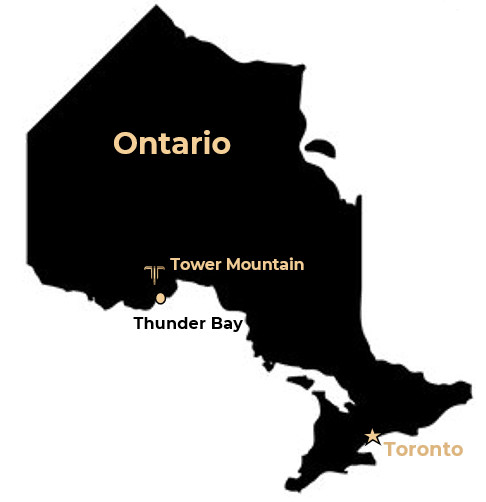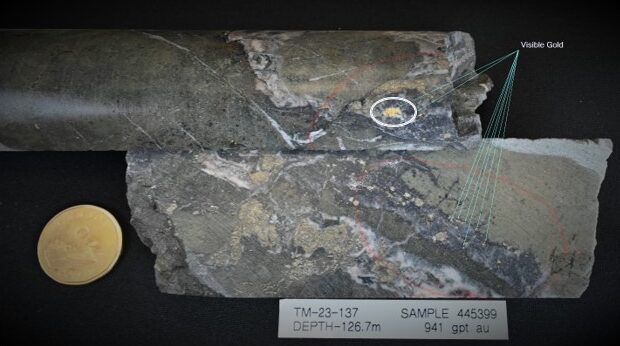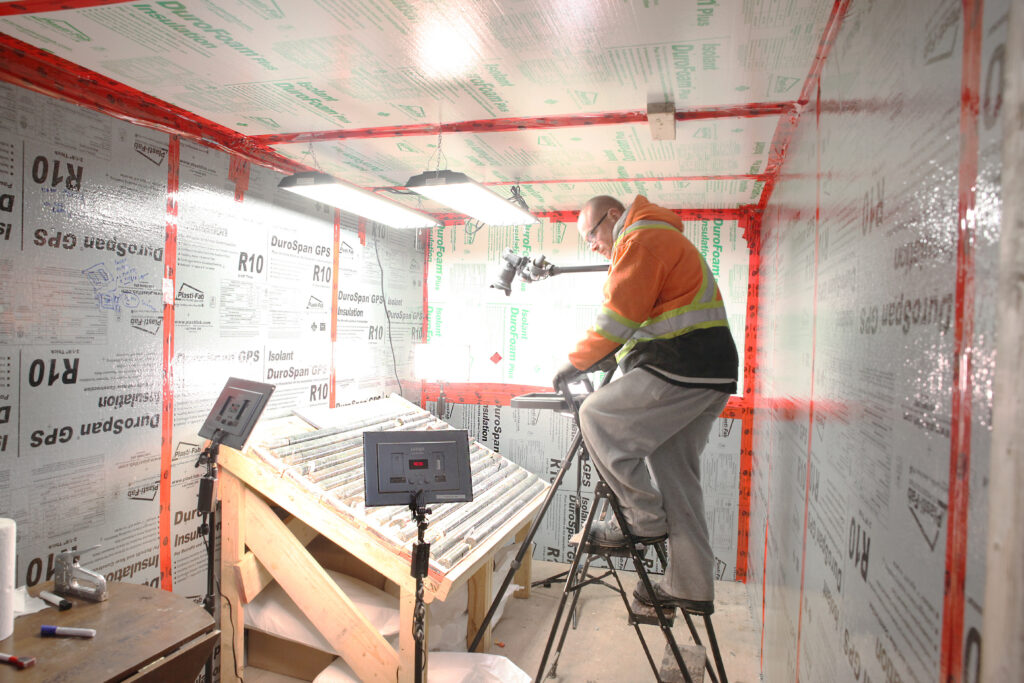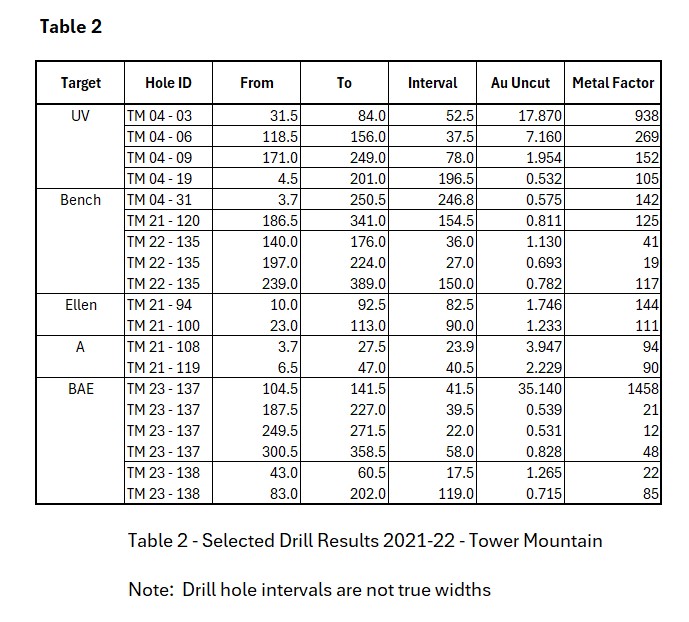Tower Mountain - Thunder Bay, Ontario
The Tower Mountain Gold Property (“Tower Mountain”) consists of 115 single cell mining claims, 64 optioned claims, 11 boundary claims, 1 owned patent and 5 patents held under option, totalling 2,650 hectares. The Company is earning a 100% interest in the property and all agreements are current and in good standing.
2024 Objectives – Focused on Tower Mountain:
1. Complete minimum CAD$2.0M financing:
Phase One Drilling Program
Eastern Intrusive Contact incl. the P target (6.0 g/t Au)
1,800 m strike length
200 m section lines with 2 holes (500 m) per section)
Target 100 and 200 m from surface
Est. metres = 5,000 (est. 3-4 months)
2. Complete minimum CAD$5.0M financing:
Phase Two Drilling Program
Northern and Southern Intrusive Contact
Select in-fill drilling along Eastern Contact, if warranted
3,600 m strike length
200 m section lines w 2 holes (500 m) per section)
Target 100 and 200 m from surface
Est. metres = 10,000 (est. 3-6 months)
3. Initiate NI 43-101 Mineral Resource Estimate
Location & Access
- Tower Mountain is located approximately 50 km west-northwest of Thunder Bay, Ontario just south of the Trans-Canada highway. It offers year-round road access and excellent local infrastructure.
- The Tower Mountain property is centered at approximately 48º 31’ 08’’ N Latitude; 89º 42’ 06’’ W Longitude (UTM Coordinates 300500E; 5377500N Zone 16N NAD83 Datum).

Regional and Local Geology
Tower Mountain is in the Archean Superior Province, Wawa Subprovince, consisting of slivers and belts of komatiites, basalts, dacites and rhyolites and associated metasedimentary rocks intruded by numerous granitoid plutonic rocks. The property lies within the Shebandowan Greenstone Belt, a late Neoarchean intercratonic basin assemblage that consists of potassium rich shoshonitic volcano-plutonic rocks interlayered with calc-alkalic rocks with abundant, massive, unsorted volcanic hematized breccias and polymitic conglomerates, arkose, mudstones and iron formation.
The northeastern portion of the property is dominated by the Tower Mountain Intrusive Complex (“TMIC”) a multi-phase alkalic intrusion measuring approximately 2,200 metres by 1,200 metres. The TMIC intrudes alkaline volcanic rocks consisting largely of latite-andesite flows and tuffs. Both the volcanics and intrusives demonstrate varying degrees of ankeritization, hematization, sericitization and potassic alteration (REFERENCE FIGURE 1.0).
Mineralization
Twenty-six (26) gold occurrences have been identified to-date, within and adjacent to the TMIC, suggesting at least one phase of the TMIC was enriched in gold (REFERENCE FIGURE 1.0). The majority of the known occurrences to-date lie within a 500-metre halo surrounding the TMIC. All diamond drilling to-date has largely focused on a 1,500 metre x 500-metre-wide area west of the TMIC that includes the UV and Bench showings, the most advanced showings discovered to-date.
Drill results indicate broad, consistent, large-tonnage, low-grade gold mineralization (averaging ~0.8 g/t Au, with some high-grade intercepts up to 941.0 g/t Au over 1.5 metres). The gold mineralization persists over 100’s of metres in virtually all holes drilled to-date. Higher grade gold mineralization appears localized within and proximal to syenite-monzonite dikes and sills, the orientation and frequency of which is currently being evaluated. Pyrite content appears to be a key indicator of increased gold grades and Induced Polarity has been proven to be an effective vector for exploration success, particularly at the Bench target. Pyrite content appears to be a key indicator of increased gold grades and Induced Polarity (“IP”) has been proven to be an effective vector for exploration success, particularly at the Bench target. IP has identified numerous targets on the east side of the intrusion which has yet to be drilled. The surface samples from the east side of the intrusion are the highest gold grades of all the surface samples on the property. This is then next area where drilling will be focused.
Exploration Model
The Company believes that the gold mineralization at Tower Mountain may represent the upper expression of an Intrusion Related Gold Deposit (“IRGD”). IRGD-type deposits offer increased opportunity for Tier One gold discoveries, typically offering deposits of greater than 100 M tonnes, averaging between 0.75 to 1.25 g/t Au and containing greater than 5.0 M oz. of gold. The Company advises that this represents the exploration target it is seeking to establish at Tower Mountain through systematic exploration.
The current database for the property consists of:
- 183 diamond drill holes totaling 41,000 metres
- 24,711 drill hole gold assays
- 3,894 multi-element ICP assays from drill core
- 885 surface rock samples
- 58 surface channel samples
- 566 line-kilometres of airborne magnetic survey and
- 529 ha Induced Polarity DASVision™ (“IP”) geophysical survey

Figure 1. Tower Mountain property with known gold occurrences
The Tower Mountain Intrusion is shown in pink. The “halo” of gold mineralization extends roughly 500 metres around the intrustion, shown by the red dotted line. The black line outlines the Tower Mountain property which is 100% owned.
Exploration
The Company delivered on all it’s primary exploration objectives in 2021-22, establishing continuity of mineralization at depth at the Bench target, expanding the Bench target along strike and down dip, identifying new zones of mineralization at Targets A, T, 110 and Ellen and confirming the overall grade tenor and extent of the previously reported mineralization. Table 2 summarizes select significant results from the targets drilled in 2021-22.
The Company’s exploration to date at Tower Mountain was undertaken with the following objectives:
- Confirm tenor and extent of the low-grade gold mineralization as indicated in the historical drilling completed by others;
- Confirm the depth potential of historical targets drilled to date;
- Test prioritized targets identified by the DASVision IP survey;
- Confirm through drilling the high-grade gold mineralization identified by surface channel sampling at the A Zone and
- Evaluate the potential for mineralization between the Bench and UV targets;
Significant results of the 2021-22 Exploration program include:
- Collected 58 surface channels samples at the A target. Results ranged from 0.07 to 23.60 g/t Au and averaged 3.16 g/t across a 20-metre wide zone for a distance of 75-metres;
- Completed seven (7) holes targeting the A target channel samples to a depth of approximately 75 metres from surface returning results as summarized in Table 2.0;
- Target A, located midway from the UV and Bench targets, remains open in all directions;
- Confirmed anomalous gold mineralization at the Ellen and 110 targets, identified as high chargeability anomalies by surface IP;
- Confirmed the continuity of the Bench zone at depth with holes TM22-134 and 135, two of the deepest holes to date, both of which reported several hundreds of metres of anomalous mineralization.



Metallurgy
In Q3-2022, the Company submitted twelve (12) samples for preliminary metallurgical testing to evaluate potential processing options and metallurgical recovery rates of typical Tower Mountain mineralization. The samples were collected from representative half drill core from various grade bins. 5-10 centimetre pieces within each interval were sent for petrographic analyses and another small sample was collected from each metallurgical interval and submitted for whole rock geochemical analyses.
Gold grades ranged from 0.295 g/t to a high of 3.641 g/t and averaged 1.07 g/t Au.
Standard, bottle roll cyanide leach tests were completed on 2.0 kg charges. Each sample was crushed and pulverized 80% passing 75 µm. The samples were placed into a 40% by weight solution with 1.0 g/L NaCN and rolled for 72 hours.
The bottle roll tests indicated metallurgical recoveries ranging from 72.5% to 94.9% and averaged 86.8% for the twelve samples (REF. Figure 2.0 – Gold Leach Kinetics – Tower Mountain – 2022). The results suggest that the Tower Mountain mineralization is amenable to direct cyanidation recovery methods, that the mineralization is not refractory and recoveries in excess of 90% are likely achievable.


Figure 2.0 – Gold Leach Kinetics – Tower Mountain
The metallurgical testing included standard bond work index analyses which returned a value of ~ 20W (kWh/tonne).
The tailings from the bottle roll leach tests were tested for Acid Based Accounting and results indicate that the tailings are not acid generating returning an average Net Neutralization Potential of ~60.3 kg Ca CO3 equivalent per tonne indicating that the tailings are not acid generating.
